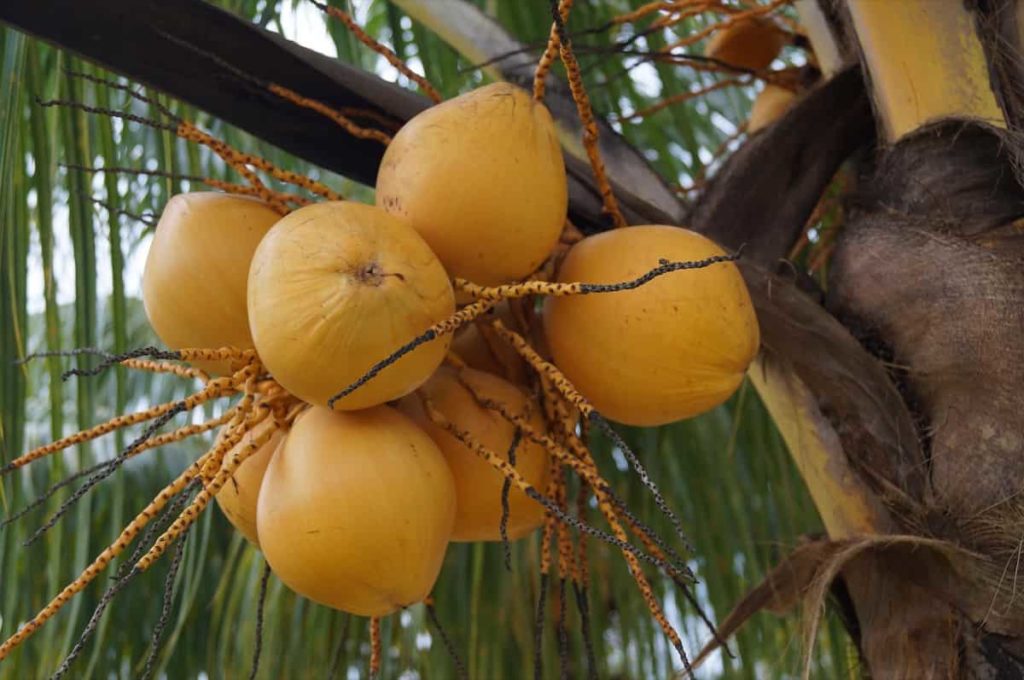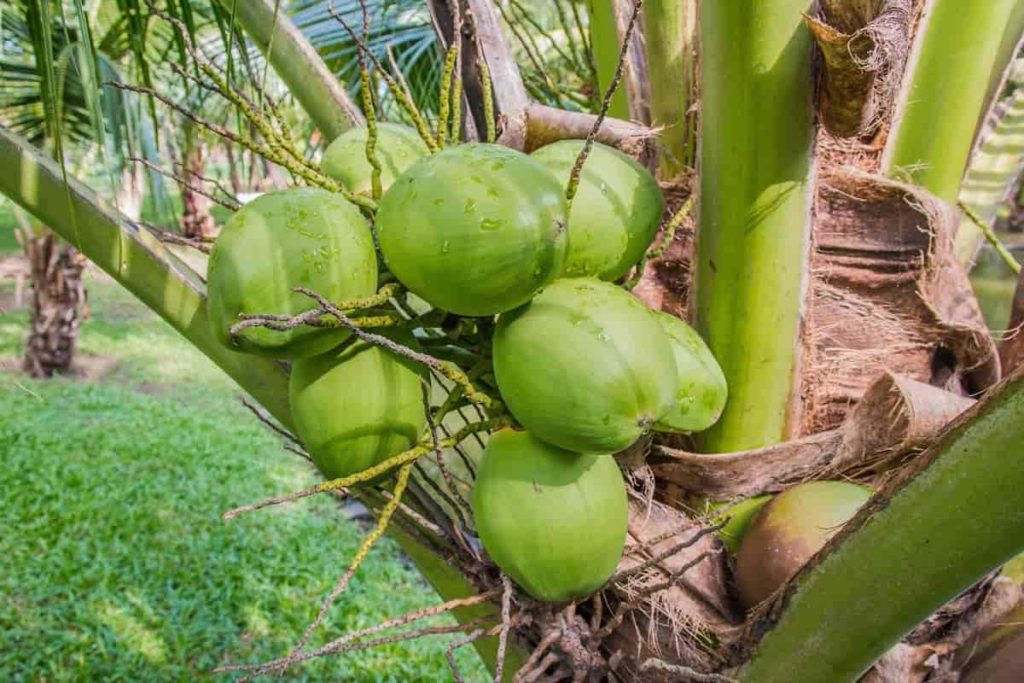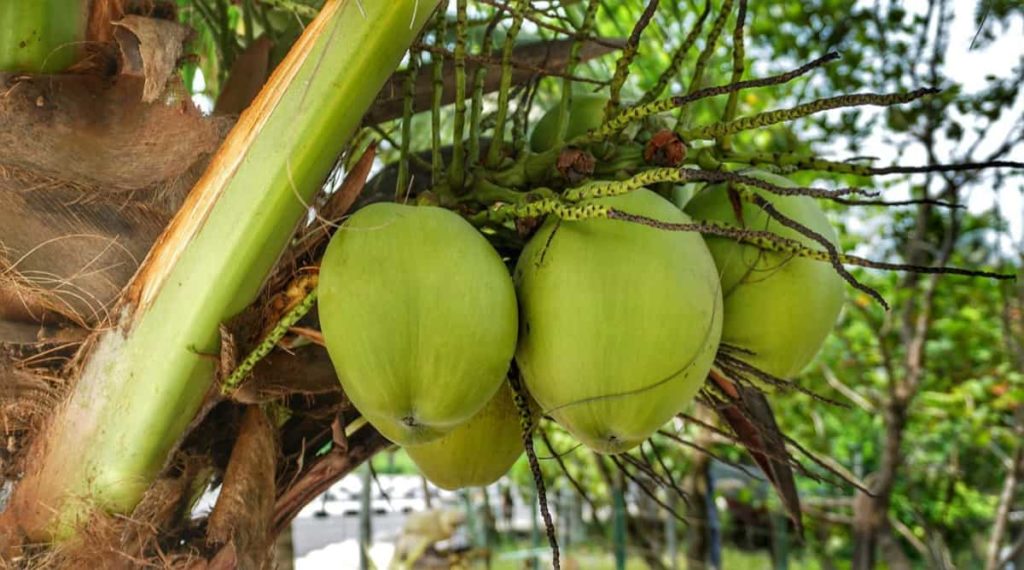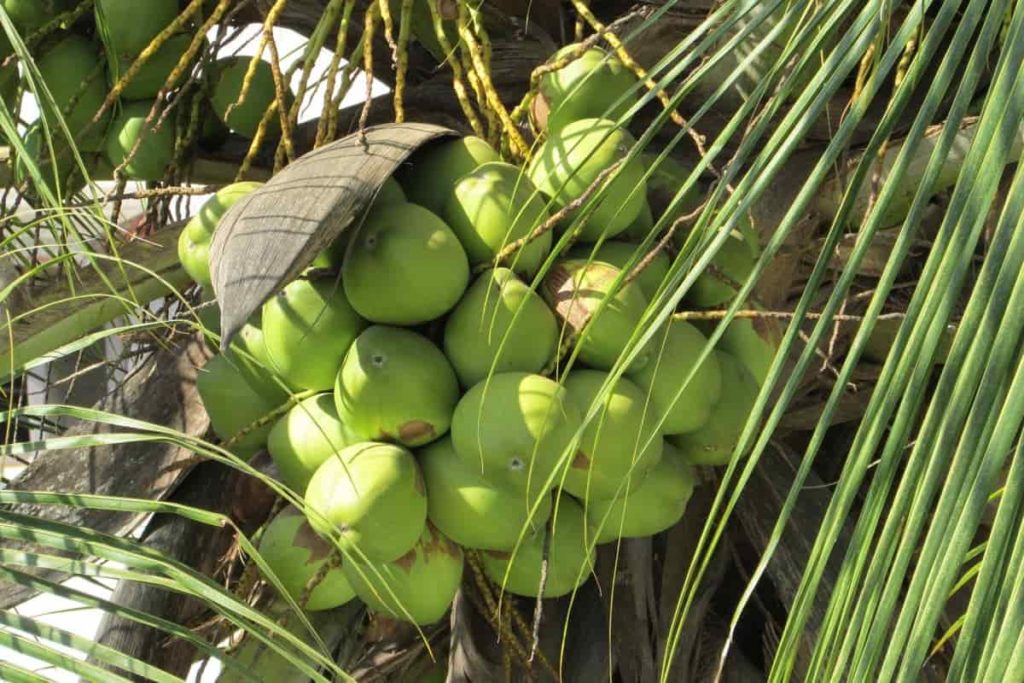The Coconut tree is not only beautiful but also very useful. Commercially valued for beauty products, oils, and raw fruit, Coconut is grown in areas with massive tropical weather. However, various types of Coconut tree problems can interfere with the healthy growth of this tree. Hence proper diagnosis and treatment of Coconut tree problems are necessary for the tree to flourish.
While it may take a lot of work to keep Coconut trees healthy, once you’ve put your plant in one position, happily, you’ll know the war has half won. Every day, with plenty of water supply, a well-drained soil mix will ensure that your Coconut tree never starves and root rot.

Common Coconut tree problems
Coconut leaves turning brown
The leaves will turn brown if your Coconut tree doesn’t get enough water. This is because dehydration will first affect the roots from where the water flows to the leaves. The last place to receive water is leaf tips, so if they turn brown, it may be a sign that the plant is not getting the required water.
Solution – If you want to save the plant, you have to change the water routine. Although they like heaps of water daily, they also need well-drained soil; otherwise, the water will accumulate around the roots and cause root rot. Make sure that the pot you are using has many drainage holes, if not, the time to change the pot as soon as possible. Too much water around the roots will also cause brown tips to the leaves.
Brown spots on your Coconut leaves
One of the main reasons for brown spots on Coconut leaves is leaf spot disease.
- Brown leaf spot – You will see that these spots start at the upper surface. Often affect old plants and can spread to about 4 millimeters wide. You may have difficulty seeing them on the underside, but this is where most spores are produced.
- Grey leaf spot – These spots are larger than brown spots and can be up to 15 millimeters in size. Sometimes they are seen running into each other and making grey drops.
Solution – Both rain and wind will help spread these spores and cause leaf spots on your Coconut palm, so it is important to check them during wet weather. Removing and burning infected leaves is an excellent idea to prevent spores from spreading to other healthy plants. If you are growing your Coconut seedlings, you should ensure that you have given them a far space enough so that they are not crowded as the leaf spot will affect any plant nearby. Some fungicides will help eliminate leaf spots.
Pencil point disorder
Due to a lack of micronutrients, the stem will taper towards its tip with a small number of leaves. The leaves will be very small, and the leaves will be pale and yellow.
Solution – With the recommended fertilizer dose, 225 grams of borax, zinc sulfate, manganese sulfate, ferrous sulfate, copper sulfate, and ten grams of ammonium molybdate can be dissolved in 10 liters of water and poured into a 1.8-meter radius basin. You can correct this disorder if attention is paid quickly. Severely infected palms can be removed and replanted with new seedlings.
Button shedding in Coconut
It is a common problem to shed a button on the Coconut prematurely. It can shed buttons after fertilization, and some nuts are shed after setting. This is not for one reason but can be caused by a combination of one or more factors. Economic losses range from 10 to 20 percent.
Buttons and premature nuts shed can be caused by one or more of the following: excess acidity or alkalinity, poor drainage facilities, severe and prolonged droughts, genetic disorders, inadequate nutrients, improper pollination, hormone deficiency, pests, or poor management methods.
Solution – Soil pH correction can cause excess acidity or soil alkalinity button shedding. Soil is very acidic if the soil has a pH of less than 5.5. You can overcome this by adding lime. High alkalinity is indicated by soil pH, which is more than 8.0. This situation can be managed by including gypsum.
In case you missed it: How to Grow Coconut from Seed at Home: Germination Process, Soil, and Climate Requirements

Nutritional deficiency button shedding can result from inadequate manuring. The recommended dose manure schedule is important to minimize button shedding. Applying 1.3 kg urea, 2 kg single super-phosphate, and 2 kg potash, mixed with 50 kg farmyard manure per palm.
Button shedding will be severe from March-April. Severe droughts and inadequate irrigation aggravate this problem. Ensuring plenty of irrigation during summer and drainage during winter will lead to sustainable production. When young buttons are formed, sucking pests begin to suffer, attracting secondary fungal infections. Apply recommended plant protection measures to avoid the problem. To prevent boron deficiency, apply 200 grams of borax per palm per year in two splits.
Yellowing the lower leaves
Yellowing the lower leaves may be a sign of overwater but equally a by-result of maturity. If the old leaves turn yellow quickly, one by one, it may be more water to blame.
Solution – People do not realize that the plant’s root system also needs access to oxygen; when the soil is watered, the air will travel upwards and out of the potting mix. The lack of accessible oxygen for the roots will cause them to break down later in the coming days. You should water Coconut when the upper soil is dry.
Dying Coconut palm
Root rot
Your Coconut tree doesn’t enjoy having wet feet. It would be decidedly unhappy because the excess water around the roots would cause root rot. Root rot symptoms include leaves that look yellow, stunt growth, and the plant’s brown, rotting base. If you remove the plant from the soil, you will find that the root ball has turned or is turning to mush.
Spider mites
These small pests are almost invisible, but spider mites cause terrible damage to the plant by suck chlorophyll from leaves. If you turn the leaf and look down at the rib underneath, you may see small webs and yellow lumps.
Mold on the soil
It is usually caused by two things, namely not enough light and not too much water. While the mold won’t kill your plant, it can become a home for pests that will damage your plant. To remove the mold, remove the top 2 inches of soil and replace it with a fresh mix. If the light is a problem, you must find a different area where the Coconut plant gets more direct light.
Very low humidity
You will find that this is the problem with your Coconut tree when the leaf tips start to brown and yellow. Then, although it can’t kill your plant, it gives the plant an ugly look. If this is not corrected, all new developments will be affected. You can increase moisture around the plant by frequently blurring or placing pebble trays that you keep filling with water.
Leaf disease
The Coconut plant suffers from a variety of leaf spot diseases. They all affect the plant similarly, i.e., by producing spores on leaves and slowly affecting the plant. You mustn’t have any infected plants near healthy plants as they will also be affected.
In case you missed it: Coconut Coir Benefits for Gardening, Making, Uses

Cold temperature
Your Coconut plant will need to be in temperature between 18 to 30°C. If the temperature drops below it, the plant will likely die. You will see stunted growth and black leaves if it doesn’t die.
Solution
There are three main ways to revive the Coconut plant. Although your plant may die of disease, these are one or more ways that usually kill Coconut plants; light, water, and moisture. Your Coconut plant needs full sunlight to grow properly. They will never do well unless they have full direct sunlight every day. Never be tempted to keep your plant in half shade and half sunlight, as it will not do well. The only exception to this rule is if you have a relatively immature plant when you can do it until it gets used to full sunlight.
The Coconut plant drinks gallons of water every day. Soil needs to be continuously moist though it also has to be drained to prevent waterlogging and root rotting. The amount of water your Coconut tree needs, in a natural environment, the plant will use between 55 and 110 liters of water every day. The natural climate of the Coconut plant is very humid, and that’s what they need. You will need to mist the plant daily when the air is dry in winter.
Coconut leaves drying
One of the main reasons why Coconut palm leaves dry is the air around them. The air is likely to be very dry for the plant. Remember, your Coconut palm comes from the regions, and dry air won’t do any good to it. Another reason for dry leaves is that the room it is in does not provide enough light or warmth. The lack of condition of any of these two will cause the leaves to dry and even be brittle.
Solution – You must change the conditions around the plant. You should introduce some extra moisture in this area. You can add a pebble dish to the base and keep it full of water, and you can also mist the plant with water from a spray bottle every day. If this area is not in full sunlight, you should move the plant elsewhere so that there is full sun every day for as long as possible.
In case you missed it: Top 20 Steps To Boost Your Apple Fruit Yield: Fruit Size Increase Tips and Ideas

Nutrient deficiency
Nitrogen deficiency
Nitrogen deficiency begins with the same light green color or yellow (uniform chlorosis) of the oldest leaves. Yellowness starts from the tip of the lower leaves to the base and will move forward. Growth stops virtually when the nitrogen deficiency is severe and leaves become flowing.
Solution – Apply a foliar spray of 2% of urea thrice at fortnightly intervals or soil application of 1 to 2 kg of urea per tree or 1% of urea twice a year.
Potassium
Symptoms first appear on the oldest leaves and later spread to young leaves. Transparent yellow or orange spots are produced on the leaflets. Old leaves show necrotic spotting and curling of the leaflet tips. Symptoms of potassium deficiency are also more severe towards the tip of the leaf and less at the base of the leaf.
Solution – Prevent the shortage of potassium through regular applications of potassium deficiency and treat already deficient. You can apply 3 to 4 kg of resin-coated K2SO4 per tree. You should apply four times a year with 2 kg MgSO4 per tree.
Phosphorus
Growth, size of leaves, and the number of leaves decreased. If phosphorus deficiency is recorded, root growth is limited. There are no obvious visual signs of phosphorus deficiency other than stunting and production reduction.
Solution – Applying DAP 2% twice at fortnightly or soil application of farm yard manure 5 kg of tree twice at fortnight break. Root feeding of 2 milliliters of DAP twice a year.
Diseases
Red palm weevil
Under plantation, young palms are particularly prone to this disease in dense. These events are common with more relative humidity during wet weather.
Solution – Apply borax mixture or 1% copper fungicides after removal of infected dead tissues. As a precautionary measure, the crown of healthy palms in the vicinity of the affected palms should be treated by placing fungicides in the young palm excel.
Leaf Blight
In advanced stages, these spots combine to form large brown areas that appear scorched.
In case you missed it: How to Prepare the Soil for Grapevine/Plant: Best Soil Mix, pH, Compost, and Recipe

Solution – Apply potash or kitchen ash. Improve drainage in water-filled lands. In a severe attack, spray 1% copper fungicides or Bordeaux mixtures.
Stem bleeding
Initially, a thick rust-colored liquid oozed from long cracks on the skin of the stem. The basic fibrous tissue of the wound is black and rotten.
Solution -Apply Bordeaux mixture or 1% copper fungicidal solution to the wound after removing dead tissues from the sites.
Bole and root rot
Initially, the reddish-brown flow can be seen near the base. Yellowing and drooping can be seen in the lower fronds in the advanced stages.
Solution – Use fungicides 70% of the Calixin and cut down and burn the affected plants.
Pests
Red palm weevil
Usually, 3-15-year-old palms are prone to pest attacks. Yellowing of the inner whorl of leaves occurs in the advanced stage of infestation. When the palm dies, the crown falls or dries up.
Solution – Use the pheromone trap to attract weevils and kill the collected ones. If an attack of rhinoceros beetle is prevalent, if leaf rot and bud rot are observed, follow the recommended use of fungicides as the weevil lays eggs in such palms. Inject attacked palm with 0.1% Endosulfan (3 ml /l water) or 1% carbaryl (20 gm/l water).
Coconut mites
It causes considerable damage to nuts by sucking juice. As a result, damaged and small-sized nuts, immature nuts, and dry outer skin, cracks are often reflected in patches.
Solution – Spraying biopesticides on the bunches. 2% neem oil-garlic oil emulsion (20-milliliter neem oil, 20 grams of garlic, 1l5 grams bar soap in 1litre of water). The emulsion has to be prepared on the same day of application.
In case you missed it: 18 Common Rose Plant Problems: How to Fix Them, Solutions, and Treatment

Conclusion
Finally, ensuring that your plant gets as much natural direct sunlight as possible daily will give you a plant that adorns any house, courtyard, or garden. Coconut trees suffer from some diseases. Few are harmful, and some gradually affect the tree by reducing overall production. So, you should know the symptoms of diseases, pests, and common growing problems. You will prevent some of the problems by giving the necessary needs of the Coconut.
- How to Grow Hibiscus from Flower
- Plantation Ideas for Home Decoration: A Beginners Guide
- Flower Garden Designs and Layouts for Beginners
- Planting and Spacing Techniques in Papaya: A Beginner’s Guide
- Growing Gold: Essential Techniques for Planting Pineapples
- How to Make Kalanchoe Plant Bushy: Home Remedies and Solutions
- 11 Reasons Why Your Gardenia is Not Blooming: Home Remedies and Solutions
- Eco Elegance: The Guide to Designing a Drought-Tolerant Landscape
- Gardening on a Slope: Strategies for Hillside Landscaping
- Nourish and Flourish: Top Organic Mulches for Thriving House Plants
- Everything You Want to Know about Indian Mogra Flower: Discover Uses and Growing
- Green Thumb Success: Expert Tips for Cultivating Greenhouse Pumpkins All Year Round
- Maximize Growth & Flavor: The Ultimate Guide to Companion Planting in Herb Gardens
- How to Control Rhododendron Problems Naturally: Home Remedies and Organic Ways to Fix Them
- Natural Magic: The Remarkable Benefits of Cinnamon for Plants
- Best Steps to Revive Dying Tulip with Natural and Organic Treatment
- 10 Reasons Why Your Angel Trumpet is Not Blooming: Remedies and Treatment
- How to Fix Periwinkle Leaf and Flower-Related Problems: Natural Remedies and Solutions
- How to Fix Zinnias Leaf and Flower Problems: Discover Natural and Home Remedies
- Organic Steps to Induce Lemon Tree Flowers: A Comprehensive Guide
- Bloom Booster: Crafting the Perfect Homemade Bougainvillea Fertilizer
- Optimizing Growth: A Guide to Applying NPK Fertilizer for Potted Plants
- 10 Best Homemade Fertilizers for Rubber Plant: DIY Recipes and Application Method
- How to Boost Female Pumpkin Flowers: Effective Steps for More Flowers and High Yields
- Transform Your Indoor Garden: Top Benefits of Pink Salt for Houseplants
- 10 Best Homemade Fertilizers for Peacock Plants (Calathea): Easy DIY Guide
- Unlock Blooms: 9 Reasons Why Your Potted Chrysanthemum is Not Blooming
- 8 Reasons Why Your Potted Hibiscus is Not Blooming: Fix it with Simple Solutions
- Unlock Blooms: 9 Key Reasons Your Potted Frangipani Won’t Flower
- 10 Reasons Why Is My Ice Plant Not Blooming: Remedies and Treatment
- 10 Reasons Why My Potted Hydrangea Not Blooming: Treatment and Remedies
- 10 Reasons Why is My Wisteria Not Blooming: Remedies and Treatment
- 10 Reasons Why is My Goldfish Plant Not Blooming: Remedies and Treatment
- Maximize Your Space: Ultimate Guide to Balcony Gardening with Grow Bags
- 10 Reasons Why Your Iris is Not Blooming: Remedies and Treatment
- 10 Reasons Why Your Anthurium Plant is Not Blooming: Treatment and Remedies
Please what could cause a coconut tree to die suddenly, mean while a week before that some coconut were harvested
My coconut tree damaged partly due to affected by insects.I have removed.but the trunk is eaten deeply.it will survive or not.
Please give me a reamedy